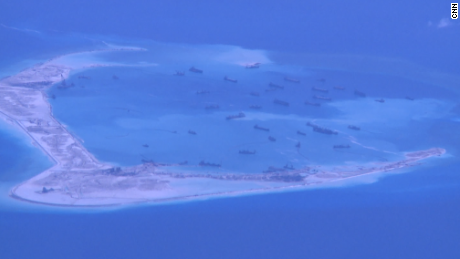South China Sea: What's at stake
Story highlights
- China has been fortifying disputed islands in the South China Sea
- New US secretary of state has said China's island-building must stop
(CNN)Dotted with small islands, reefs and shoals, the South China Sea is a crucial shipping route and home a messy territorial dispute that pits multiple countries against one another.
Tensions in the contest waters have ratcheted up since 2014 as China has turned sandbars into islands, equipping them with airfields, ports and weapons systems and warned US warships and aircraft to stay away from them.
Adding fuel to this heady mix, the Trump administration looks set to take a much more confrontational stance toward Beijing than its predecessor -- setting the stage for a potential showdown.
Here's what's at stake:
Who claims what?
China bases its claims on the "nine-dash line" -- its claimed territorial waters that extend hundreds of miles to the south and east of its island province of Hainan, abut its neighbors' claims and, in some cases, encroach upon them.
The Paracel Islands (Xisha to Beijing) have been controlled by China since 1974, but they are also claimed by Vietnam and Taiwan. Tensions flared in 2014 when China installed exploratory oil rigs in the vicinity.
The situation is more complicated in the Spratlys, which Beijing calls the Nansha islands.
The archipelago consists of 100 smalls islands and reefs of which 45 are occupied by China, Malaysia, Vietnam or the Philippines.
All of the islands are claimed by China, Taiwan and Vietnam, while some of them (or nearby waters) are claimed by the Philippines, Malaysia and Brunei.
What's China been building?
In early 2014, China quietly began massive dredging operations centering on the seven reefs it controls in the Spratly Islands -- Fiery Cross Reef, Subi Reef, Mischief Reef, Cuarteron Reef, Gaven Reef and Hughes Reef.
According to the US, China has reclaimed more than 3,000 acres since the beginning of 2014.
On his 2015 trip to Washington, Chinese President Xi Jinping said China wouldn't militarize the islands, but a December report from the Asia Maritime Transparency Initiative (AMTI) said China had installed comprehensive weapons systems on seven reefs that include anti-aircraft guns.
Some have called the islands China's "unsinkable aircraft carriers."
Vietnam, Malaysia, the Philippines and Taiwan have also reclaimed land in the South China Sea, but their land grab -- the US says approximately 100 acres over 45 years -- is dwarfed by China's massive, recent buildup.
What's the US view?
It could be changing.
The US has traditionally taken no position on the territorial disputes in the South China Sea but has repeatedly asserted its right to freedom of navigation in the disputed waters, with the US military flying and sailing its assets close to the islands China controls.
Tillerson and Trump have not minced their words on the issue, suggesting that the State Department could take a more muscular approach.
"Building islands and then putting military assets on those islands is akin to Russia's taking of Crimea. Its taking of territory that others lay claim to," Tillerson said in his confirmation hearing.
"We're going to have to send China a clear signal that first, the island-building stops, and second, your access to those islands also not going to be allowed."
Blocking Chinese naval vessels from accessing South China Sea reefs would almost certainly trigger a US-China clash, says Ashley Townshend, a research fellow at the United States Studies Centre at the University of Sydney.
"More to the point: as many of the reefs are effectively a part of international waters, preventing Chinese ships from sailing to or near them would undermine the very freedom of navigation rules that the US has been trying to uphold," he adds.
What could China do?
As China stretches its muscles as a growing superpower, the South China Sea, rich in oil and gas reserves, has become a testing ground for whether the country will rise as part of the existing international order or outside it.
China says both the Paracels and the Spratlys are an "integral part" of its territory, offering up maps that date back to the early 20th century.
It has repeatedly defended its right to build both civil and defensive facilities on the islands it controls. In December, a Chinese warship unlawfully seized an underwater drone from a US oceanographic vessel.
One new strategy could be to declare an air defense zone in the South China Sea, which would require all aircraft to file flight plans even if they don't enter Chinese airspace.
Beijing has also ignored a landmark ruling last year by the Permanent Court of Arbitration in The Hague, which said there was no legal basis for China's maritime claims.
Even though they now have international law on their side, other claimants have done little to challenge Beijing. The Philippines, which originally brought the case, has pivoted towards Beijing under President Rodrigo Duterte.
Beijing's response to Tillerson and Trump's comments to date has been fairly muted, but some analysts think Beijing could soon test the new US commander in chief.



No comments:
Post a Comment